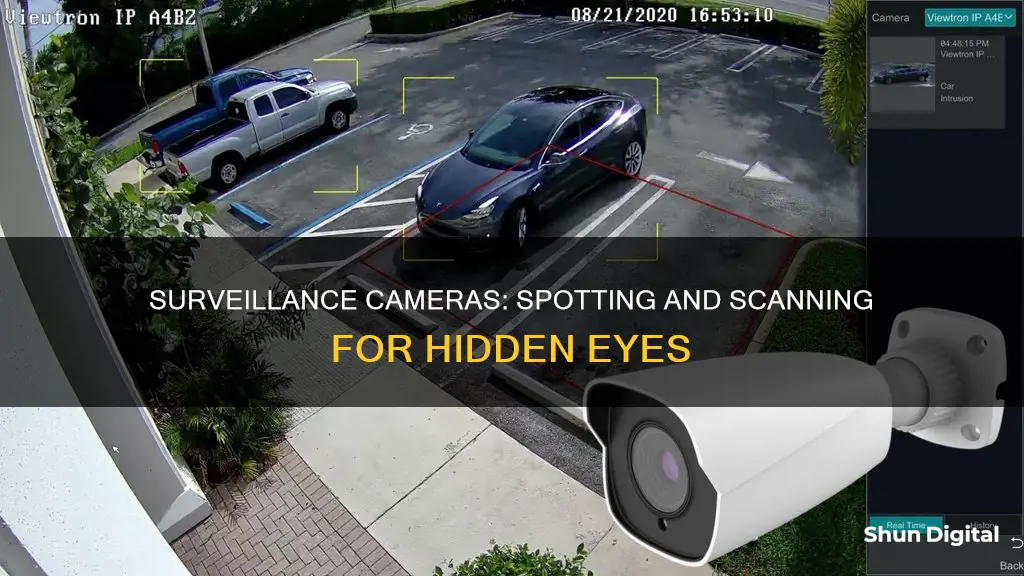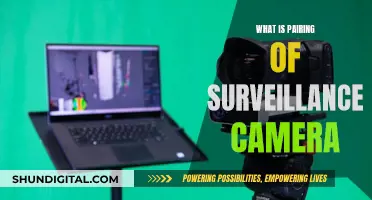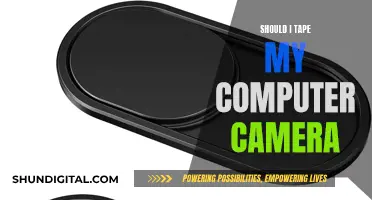
Surveillance cameras are an increasing concern for personal privacy. Hidden cameras can be found in a variety of places, from hotel rooms to public restrooms, rental properties, and even your own home. They can be disguised as everyday objects such as smoke detectors, alarm clocks, or USB chargers. Detecting these cameras can range from a simple physical inspection to using a professional radio frequency (RF) detector. Here are some ways to scan for surveillance cameras and protect your privacy.
| Characteristics | Values |
|---|---|
| Scan the environment | Check for unusual objects, wires, or lenses. Listen for an inaudible buzz. |
| Use a flashlight | Turn off the lights and use a flashlight to check for reflective lights from camera lenses. |
| Look at the Wi-Fi network | Check the number of devices connected to the router. Use a Wi-Fi scanning app to identify unknown devices. |
| Use a mobile phone | Make a call and walk around to detect signal interference. Use the front camera in a dark room to detect infrared lights. |
| Use a radio frequency detector | Purchase a professional-grade RF detector and slowly scan the room. Listen for auditory alerts. |
What You'll Learn

Use a mobile phone camera or an infrared detector
Using a Mobile Phone Camera or an Infrared Detector to Scan for Surveillance Cameras
Using a mobile phone camera or an infrared detector is one of the fastest ways to find hidden surveillance cameras. This method works by detecting infrared (IR) lights emitted by cameras, which are invisible to the naked eye.
Using a Mobile Phone Camera
Most surveillance cameras use infrared lights to capture moments in low light or darkness. While you cannot see these lights with your eyes, they can be detected by your smartphone camera.
To use your phone to scan for surveillance cameras:
- Test your phone's camera: First, you need to determine if your phone's camera can detect IR lights. To do this, grab an infrared remote control (such as a TV remote) and point it at your phone's camera. Press a button on the remote, and if you see a light on your screen, your phone's camera can detect IR.
- Scan your surroundings: Turn off the lights in the room and activate your phone's camera. Scan around the room, looking for any unusual lights on the screen. These may appear as bright red, purple, white, or blue dots.
- Identify the camera: If you spot any of these lights, you have likely found a hidden camera. Note that not all devices emitting IR lights are cameras, so look for a lens on the device.
Using an Infrared Detector
You can also use a dedicated infrared detector or a hidden camera detector app on your phone to find hidden cameras. These tools are designed to identify IR lights and help locate hidden cameras.
To use an infrared detector:
- Scan the area: Turn off the lights and use the infrared detector to scan your surroundings. Look for any bright red or purple dots that indicate the presence of IR lights.
- Identify the camera: If you find an IR light source, look for a lens on the device emitting the light. This could be a hidden camera.
It's important to note that not all smartphone cameras can detect IR lights, and some phones may only have this capability on the front-facing camera. Additionally, other devices, such as TV remotes, may emit IR lights, so always check for the presence of a lens to confirm a hidden camera.
The Multiplane Camera: Revolutionizing Animation's Depth and Dimension
You may want to see also

Check for unusual objects, holes or keyholes
When scanning for surveillance cameras, it's important to check for unusual objects, holes, or keyholes that could potentially conceal a camera. Here are some detailed instructions to help you with the process:
- Inspect the surroundings: Carefully scan the entire room, including walls, shelves, and tables. Look for any unusual objects or items that seem out of place. Pay attention to objects with holes or keyholes, such as smoke detectors, clocks, or USB chargers. These items are commonly used to disguise surveillance cameras.
- Check for hidden cameras in screws: Believe it or not, a hidden camera can be concealed within a tiny screw. Inspect any odd screws in the room and use a flashlight to check for hidden lenses. If you're unsure, you can cover the screw with a towel as a temporary measure.
- Examine USB chargers: USB chargers with hidden cameras are relatively easy to spot. Look for any holes or openings on the surface of the charger, which are not typically found on standard USB chargers.
- Be vigilant with mirrors: Two-way mirrors can be used to conceal cameras. To detect these, place your fingernail on the mirror and observe the gap between your finger and its reflection. If your finger and the reflection touch tip to tip, there may be a hidden camera behind the mirror. Additionally, tap on the mirror; a dull sound indicates a regular mirror, while a sharp or hollow sound may suggest a two-way mirror.
- Use a flashlight: Turn off the lights and use a flashlight to scan the room. Hidden cameras often have blinking red or green LEDs that can be spotted in low-light conditions. The flashlight can also help identify reflective light from camera lenses.
- Listen for unusual sounds: Some hidden cameras with motion sensors may emit a faint, almost inaudible buzzing sound when in operation. As you walk through the room, pay attention to any unusual sounds that could indicate the presence of a hidden camera.
Remember, when checking for unusual objects, holes, or keyholes, it's important to be thorough and inspect every detail. Combine these techniques with other methods, such as using smartphone apps or professional detectors, to increase your chances of detecting surveillance cameras.
Mastering Photography: Understanding P Mode on Your SLR
You may want to see also

Use a radio frequency detector
Radio frequency (RF) detectors are a reliable method of finding hidden cameras. They work by detecting the radio frequency emissions of a camera. RF detectors are available in a range of prices and sizes, and can be purchased online or in stores.
When using an RF detector, it is important to first turn off and unplug all other devices that send out radio signals, such as kitchen appliances, baby monitors, routers, and TVs. These devices may affect the detecting result.
RF detectors can be used in a variety of ways to find hidden cameras, depending on the type of detector being used and its intended purpose. Here are some of the most common ways:
- Field Strength Detection: Some RF detectors can measure the strength of an RF field in the area by using a sensor to detect RF signals. Once detected, the RF signals are turned into an electrical signal, which the detector amplifies to determine the strength of the waves.
- Frequency Detection: This is the most common type of RF detector. It can identify the frequencies of RF signals through scanning and finding its frequency. Once it has a frequency, it will compare it to others and identify the specific range.
- RF Interference Detection: These types of RF detectors can find the presence of RF interference or unwanted signals that can disrupt communication or other wireless signals. They monitor the RF spectrum for unexpected signals and will alert you if they find one.
When choosing an RF detector, consider the detection range, frequency range, signal strength, alert mechanism, and any extra features. Detection range and frequency range will depend on the size of the space you need to cover and the type of area you need to detect frequencies in. A detector with adjustable sensitivity is usually preferred, as it allows you to fine-tune your device to detect weaker or stronger signals. The alert mechanism can be beeps, lights, or vibration, depending on your preference and whether you need to use the detector covertly.
RF detectors are an important tool in countering illegal surveillance and maintaining privacy and security. They can detect even small and concealed devices, and by using them, individuals and security personnel can take the necessary steps to protect sensitive areas from any unauthorized monitoring.
Slowing Camera Movement in Blender: Walk Mode Tips
You may want to see also

Inspect the Wi-Fi network
Inspecting the Wi-Fi network is a crucial step in scanning for surveillance cameras. Wireless hidden cameras often connect to Wi-Fi to enable remote viewing, so checking your Wi-Fi network for unknown or suspicious devices is essential. Here's a detailed guide on how to inspect your Wi-Fi network:
Step 1: Disconnect Your Devices
Before you begin scanning, it's a good idea to disconnect all your devices from the Wi-Fi network except for the phone or tablet you'll be using to scan. This will make it easier to identify any unknown devices that may be surveillance cameras.
Step 2: Use a Wi-Fi Scanning App
There are several Wi-Fi scanning apps available that can help you identify devices connected to your network. One popular option is Fing, which is available for both iPhone and Android devices. Fing allows you to see all the devices connected to your local network and identify any potential surveillance cameras. Other apps, such as NMap, can also be used to scan for open ports and known devices.
Step 3: Identify Suspicious Devices
When inspecting your Wi-Fi network, look for devices with names that include words like "camera," "IP camera," or "cam." These could indicate the presence of a surveillance camera. Also, keep an eye out for "unknown devices" or devices with strange names, as these could be hidden cameras. Additionally, some cameras may show up as "Generic," so be cautious of any devices without recognisable details.
Step 4: Take Note of IP Addresses
If you come across any suspicious devices, make a note of their IP addresses. You can then use this information to scan for open ports and further investigate the device. This can help you confirm whether the device is indeed a surveillance camera.
Step 5: Scan for Open Ports
Using the IP address you noted, you can scan for open ports to gather more information about the suspicious device. Tap on the "Tools" button in the app, then select "Find Open Ports." Enter the IP address, and the app will show you a list of open ports and their associated services.
Step 6: Look for Common Streaming Services
When scanning the list of open ports, keep an eye out for services commonly used for streaming video, such as RTSP and RTMP. Additionally, look for ports using HTTP or HTTPS, as these may allow you to connect to the device via a web browser and potentially view the live stream.
Step 7: Take Action
If you confirm the presence of a hidden camera, you can take appropriate action. This may include contacting the premises owner, alerting the authorities, or seeking technical assistance to remove or disable the camera. Remember to be respectful and kind when approaching the premises owner, and always prioritise your safety.
Mastering Manual Focus with the Lumix 300FZ
You may want to see also

Conduct a physical inspection
Conducting a physical inspection is a crucial step in detecting hidden cameras. Here are some detailed instructions to help you perform a thorough physical inspection:
- Begin with a Visual Sweep: Start by carefully examining the entire area, including both common and uncommon places. Look out for any oddities or items that seem out of place.
- Examine Everyday Items: Hidden cameras can be cleverly concealed within ordinary objects. Inspect items such as clocks, smoke detectors, picture frames, lamps, flowerpots, and other decorative items. Be vigilant for small lenses or pinholes that could indicate the presence of a camera lens.
- Check for Out-of-Place Objects: Be cautious when inspecting hotels or rental properties. Pay extra attention to objects that seem strangely positioned or oriented towards private areas, such as beds or bathrooms.
- Investigate Wires and Electronic Devices: Look for any unnecessary wires or devices plugged into places they shouldn't be. Hidden cameras often require a power source, so unusual wiring can be a giveaway.
- Search for Hidden Holes or Gaps: Inspect walls, decorative items, or fixtures for any small holes or gaps that could accommodate a camera. Even the tiniest openings may be used for pinhole cameras.
- Use a Flashlight: Darken the room by closing curtains and turning off the lights. Then, use a flashlight to scan the room thoroughly. This technique can help detect reflections from camera lenses, increasing the chance of spotting hidden cameras.
- Spot Indicator LEDs: In a dark room, carefully look for small blinking lights. Many hidden cameras have red or green LEDs that blink or stay illuminated in low-light conditions, making them easier to spot.
Remember to be thorough and meticulous during your physical inspection. Combine this with other methods, such as scanning Wi-Fi networks and using mobile phone apps, to maximize your chances of detecting hidden surveillance cameras.
Charging the Fujifilm XP80: A Step-by-Step Guide
You may want to see also
Frequently asked questions
One of the easiest ways to detect hidden cameras is to use a smartphone. You can either use the phone's camera to scan for infrared lights or download a dedicated hidden camera detector app.
Turn off the lights and use your phone's camera to scan for small bright dots, which could indicate the presence of infrared lights used by many surveillance cameras.
You can use a radio frequency (RF) detector to locate and identify hidden cameras by detecting their radio frequency emissions. You can also visually inspect your surroundings for anything new, out of place, or with protruding wires.







